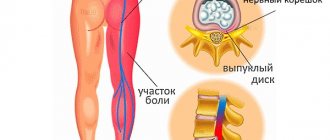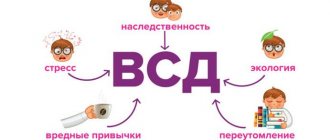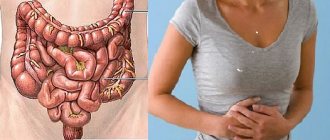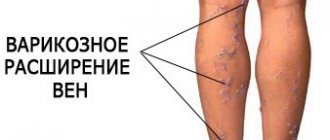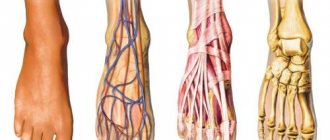Pain in the neck on the right side has a different character and can radiate to various parts of the body. Unpleasant sensations are associated with diseases of the cervical spine, neuralgia, and tumor processes. To identify the provoking factor of such pain, you need to visit a specialist and undergo the necessary examinations.
Diseases of the spinal column
If pain is noticed on the right side of the neck, this is usually associated with various pathologies of the musculoskeletal system.
Painful sensations are associated with the following dangerous abnormalities:
- Intervertebral hernia of the cervical spine. Sharp pain is associated with compression of the nerve roots. The pathology is often expressed in unpleasant sensations that extend to the shoulder and arm area. This disease can cause nerve dysfunction, which significantly reduces muscle strength and sensitivity. When the hernia is strangulated, the intensity of the manifestations increases. This can cause complete immobility, so the condition requires urgent surgical treatment.
- Cervical osteochondrosis. When the right side of the neck hurts, the patient is also suspected of having abnormalities in the bone tissue of the spine. With osteochondrosis, a decrease in intervertebral discs and a pathological proliferation of osteophytes occurs. In addition to pain, dizziness often appears and sensitivity in the affected area is impaired. The pain intensifies when turning the head to the right or left.
- Spondyloarthrosis and osteoarthrosis. In osteoarthritis, the intervertebral joints are damaged. A dull type of pain is characteristic. It is concentrated in the back of the head. The maximum severity of pain is observed in the morning. The condition worsens with physical activity. The pain radiates to the arm, head or shoulder blade. Osteoarthritis is a rapidly developing pathology that can cause disability. With spondyloarthrosis, the pain is short-term and radiates to the back of the head and scapula. With further development of the deviations, numbness in the shoulder and neck areas is observed, coordination of movements is impaired, and tinnitus appears.
- Spondylosis of the neck. If it hurts on the side, on the right side, then a similar phenomenon can cause a degenerative-dystrophic lesion. This pathology is chronic and therefore often leads to disability for the patient. With spondylosis, pain spreads not only to the neck area, but also to the occipital area, to the ears. Additional manifestations are fainting, tension in the neck muscles, intense cephalgia, numbness of the skin in the neck area.
Other Possible Factors
The right side of the neck hurts due to reasons unrelated to lesions of the vertebrae.
Other factors that provoke a specific clinical picture include the following:
- Neuralgia of the occipital nerve. The pain begins in the neck on the right and then radiates to the collarbone and shoulder blades. Sometimes they radiate to the area of the visual organs. With neuralgia, the neck usually hurts; no other manifestations or movement disorders are observed. Occipital neuralgia is caused by mechanical damage, colds, hypothermia, overstrain of the shoulder and neck muscles.
- Spinal canal stenosis. This pathology causes compression of the spinal cord. The narrowing occurs due to the presence of bone spines. As a result of damage to the spinal cord, the pain is not too pronounced, but weakness and numbness of the limbs occurs.
- Retropharyngeal abscess. A possible factor that provokes neck pain may be the indicated deviation. Externally, the pathological condition is expressed in the appearance of a spherical protrusion on the back wall of the pharynx. In addition to pain syndromes, the following symptoms are observed: impaired nasal breathing, change in voice, increase in body temperature up to 40 degrees. Pain when swallowing becomes more pronounced, so the patient cannot fully eat. Due to severe pain, a person has to throw his head back or tilt it to the side.
- Inflammation of soft tissues. Patients are often diagnosed with plexitis, an inflammatory process affecting the nerve plexuses that are formed from the branches of the spinal receptors. This pathological process causes permanent muscle weakness. Sometimes it is accompanied by breathing problems and continuous hiccups, which is associated with inflammation of the diaphragm nerve.
- Acute purulent processes in soft tissues. Pathological processes of this nature occur frequently, since a large amount of fatty tissue is localized in the neck area. Also, the neck on the right side may hurt due to pathologies such as abscess, phlegmon, boil. In these cases, swelling is observed in the affected area, itching occurs, and the skin turns red. When you feel the affected area under the skin, you feel lumps, which are an accumulation of pus. Acute purulent pathologies of soft tissues are accompanied by an increase in body temperature, as well as symptoms of general intoxication of the body. The listed diseases pose a particular danger: they can affect lymph nodes, nearby organs, and blood vessels.
- Tumor neoplasms. Malignant or benign tumors, as well as metastases, cause tissue compression. With tumors of the pharynx, in addition to pain, the following symptoms occur: sore throat, difficulty breathing through the nose, nasal voice. With neck pain on the side, on the right side, metastases can also be suspected. Lung cancer, thyroid cancer, and kidney tumors metastasize to the spinal column.
- Frequent tension (stress) and depression.
- Acute thyroiditis. This disease is inflammatory in nature and is caused by focal or extensive damage to the thyroid gland. This pathology is characterized by severe pain in the neck on the right side or in front, symptoms of intoxication appear, and body temperature rises.
Periodic or regularly recurring attacks of pain in the right side of the neck of a dull or acute nature indicate certain deviations of varying degrees of severity. To prevent complications, it is important to immediately visit a doctor to determine the cause.
Why does my neck hurt on the right?
If pain occurs in the neck, then this symptom is called cervicalgia. When irradiating to the arm we are talking about cervicobrachialgia, to the head – about cervicocranialgia. If pain is expressed on the right side of the neck, there are several possible causes for this symptom.
Cervical osteoarthritis
This disease usually progresses over several years and causes irreversible degenerative changes - the intervertebral cartilaginous plates are slowly destroyed. The cause of the pathology is often high physical activity and metabolic disorders.
Pain in osteoarthritis of the cervical spine occurs due to infringement of neuronal endings and blood vessels. It can be dull and aching in nature and intensifies during movements.
The pathology is also characterized by the following symptoms:
- pain after a long rest, which is more often observed in the morning after sleep;
- possible irradiation to the upper limbs and shoulder blades;
- dizziness when turning the head;
- instability of the cervical spine, accompanied by crunching, discomfort, and the risk of subluxation;
- unsteadiness, instability when walking;
- unstable blood pressure;
- visual and hearing disorders;
- significantly reduced taste sensations.
Osteochondrosis of the cervical spine
This pathology is diagnosed in approximately half of the population after 25 years. The reason often lies in a sedentary lifestyle.
Pain is one of the main signs of the disease. At the initial stage, it usually appears in the morning, and goes away with physical activity. On the right side, it can be localized against the background of a pinched nerve. As the disease progresses, various complications arise, and headaches may accompany neck pain. Sometimes it occurs suddenly and is so severe that painkillers do not help.
Osteochondrosis of the cervical spine is also characterized by the following symptoms:
- muscle stiffness;
- crunching during movements;
- pain in the upper extremities, numbness during sleep, tingling;
- dizziness;
- fainting – a person loses consciousness for only a few seconds, then feeling weak;
- Possible unsteadiness of gait, nausea, vomiting;
- visual disturbances: spots, fog before the eyes;
- increased fatigue, irritability.
Intervertebral hernia
This pathology is quite common. It is characterized by sudden and rapid development.
Damage to the cervical spine is accompanied by pain, which can be localized only on one side.
The disease can also be expressed by the following symptoms:
- pain radiates to the shoulders, shoulder blade, thumb;
- painful sensations intensify when turning the head;
- burning;
- numbness and tingling in the hands;
- loss of sensation;
- losing weight in one limb;
- the condition may improve when the arms are raised up;
- stiffness.
Spondylosis
This pathology is degenerative in nature and is characterized by changes in the intervertebral discs.
In this case, a dull aching or nagging pain occurs. It increases with physical activity and decreases or goes away after a long rest.
Other signs of the disease are also observed:
- headache;
- dizziness;
- hearing disorders, tinnitus;
- blurred vision, flashing spots before the eyes, impaired concentration;
- muscle weakness, neck muscles in constant tension;
- sensitivity of the limbs is impaired;
- the duration and intensity of pain increases.
Injury
If the right side of the neck was injured, then the pain occurs precisely there, although it can radiate to neighboring areas. It can be aching and dull, spreads to the back of the head and is accompanied by other signs:
- weakening of the muscle reflex;
- hearing impairment;
- confusion;
- temporary loss of coordination: uncoordinated movements, unclear gait;
- a hematoma may develop, which can lead to a stroke when the arteries are compressed;
- when communication with the central nervous system is disrupted, a decrease in muscle strength and paralysis are observed.
Cervical plexitis
The disease affects the cervical plexus and can occur against the background of trauma, infection, or metabolic disorders. The main manifestation of the pathology is pain, which may be accompanied by the following symptoms:
- irradiation of pain into the chest;
- numbness;
- sensitivity disorder;
- difficulty speaking loudly or coughing;
- paresthesia;
- muscular torticollis.
Fracture
Pain is the main symptom of such an injury. Its manifestations depend on the location of the fracture:
- when the first vertebra is affected, the pain radiates to the back of the head and parietal region;
- if the second vertebra is affected, pain is felt when turning the head, possible numbness of the fingers, temporary paralysis;
- When the third vertebra is damaged, severe pain and significant limitation of movements occur.
In most cases, such a cervical injury is accompanied by swelling and hardening of the muscles. Sometimes there is a headache, dizziness, and increased heart rate.
Subluxation of the cervical vertebra
Such an injury means that the articular surfaces of the cervical vertebrae are displaced relative to each other. This disorder is accompanied by pain in the cervical spine. It can only be localized on the right side.
The injury is accompanied by other symptoms:
- painful palpation;
- soft tissue swelling;
- headache;
- dizziness;
- muscle tension;
- sleep disorder;
- the patient is forced to hold his neck in one position;
- noise in ears;
- cramps in the hands;
- possible irradiation of pain to the shoulders, back, jaw.
Myositis
This disease is characterized by an inflammatory nature and affects the neck muscles and shoulder girdle. The pain can be localized on the right side and increases with bending and turning the head.
Myositis is also characterized by the following symptoms:
- pain radiates to the back of the head, crown, upper back, between the shoulder blades, right arm, shoulder girdle;
- the intensity of the pain syndrome gradually increases;
- slight swelling develops in the area of the affected muscles;
- inflamed muscles are tense and tight;
- local temperature increase;
- painful palpation;
- if the disease becomes chronic, the pain becomes recurrent and is provoked by even minimal exertion or a short stay in an uncomfortable position.
Neuralgia of the ear ganglion
Pain in the neck on the right with this pathology is a secondary sign, since it radiates to this area when the right ear and parotid region are affected. Painful sensations can also affect the lower jaw, back of the head, shoulder girdle, arm, and upper chest.
The disease is also characterized by the following symptoms:
- vegetalgia syndrome – burning, bursting, aching pain;
- clicking in the affected ear;
- salivation increases;
- the sore ear is stuffy.
Lymphadenitis
This pathology means damage to the lymph nodes of an inflammatory nature. Painful sensations occur on the side of the affected area and are accompanied by the following symptoms:
- enlargement of the affected lymph node up to 5 cm or more;
- painful palpation;
- loss of appetite;
- general weakness;
- if the disease is acute, the temperature rises;
- lymphadenitis in children is accompanied by general signs of intoxication: fever, chills, nausea, headache.
Retropharyngeal abscess
An abscess is also called retropharyngeal. It is formed by suppuration of the lymph nodes and tissue of the retropharyngeal space.
There is acute pain in the neck on the right; sharp painful sensations are also observed when swallowing.
Pathology is also characterized by other signs:
- sore throat;
- refusal of food;
- violation of nasal breathing;
- the appearance of a closed nasal tone;
- temperature rise to 39-40 degrees;
- with damage to the lower parts, inspiratory shortness of breath accompanied by wheezing;
- the patient throws his head back, tilts it to the affected side and is forced to hold it in this position.
Barre-Lieu syndrome
Other names for the pathology are cervical migraine, vertebral artery syndrome or posterior cervical sympathetic syndrome. With this disease, pinching of the nerves surrounding the vertebral artery may occur, which is accompanied by migraine-like pain. It is localized on the affected side and may be accompanied by other symptoms:
- pain occurs when the head is in a forced position for a long time;
- pain intensifies during descent or ascent of stairs, walking, shaking in transport;
- increased fatigue;
- dizziness;
- burning, cold sensation, paresthesia;
- tinnitus, pain;
- nausea;
- flickering of flies before the eyes, fog.
Cyst
This pathology is represented by a formation in the form of a cavity containing liquid or mushy contents. Pain usually occurs when the cyst suppurates and is accompanied by the following symptoms:
- the neck increases in size, especially on the affected side;
- the skin under the cyst turns red;
- a fistula is formed;
- local edema forms;
- Hyperpigmentation may occur.
Spinal canal stenosis
This pathology involves a narrowing of the spinal canal.
The pain is localized in the neck and can affect only one side. It radiates into the arm, its intensity varies in different positions of the neck.
The pathology is often accompanied by Lhermitte's symptom, when when moving the neck, pain is felt in the spine, which is similar to an electric shock. Stenosis is also characterized by the following symptoms:
- decreased sensitivity in the limbs;
- cotton feet;
- difficulty walking with your eyes closed or in the dark;
- cramps in the lower extremities;
- the feet periodically twitch rhythmically;
- the functions of the pelvic organs are impaired.
Neoplasm
This pathology affects the cervical spine quite rarely, but pain in the right side can occur against the background of tumor metastasis from other organs. The danger of the disease is that its symptoms are similar to other more common pathologies.
When a tumor or metastasis occurs in the cervical spine, pain occurs. It may be accompanied by the following symptoms:
- muscle weakness, cramps;
- fast fatiguability;
- loss of appetite;
- anemia;
- weight loss;
- elevated temperature;
- coldness in the lower extremities;
- numbness, partial paralysis;
- Possible effects on the brain: severe headache, increased intracranial pressure, dizziness, nausea, vomiting.
Referring pain
Sometimes the pain radiates when tilting the head or in a quiet position down to the upper limbs and collarbones, or up to the head.
Depending on which part the pain is sent to, you can determine its origin.
If acute pain radiates to the shoulder and arm area, then the cause of this is a violation of the integrity of the intervertebral discs.
Pain extending to the back may indicate both pathological changes in the spine and rheumatic processes.
If the pain radiates to the head or towards the jaw, then the cause is an inflammatory process of muscle tissue or lymph nodes. For the same reason, pain in the neck can appear on the left, spreading to the throat and larynx.
Neurologist M.M. Shperling talks about common pain sensations in the cervical spine.
Causes of pain in a child
If a child has a sore neck on the right, then a similar symptom, just like in adults, may indicate various diseases. These include the following factors:
- Incorrect posture. Curvature of the spinal column and pain caused by this phenomenon occurs due to physical inactivity, in case of improper sitting at the table and desk, as well as when there is a reluctance to play sports.
- Impacts and injuries received during active games and activities.
- Carrying heavy things. Aching pain in the neck area can occur when wearing an overfilled backpack. A heavy load causes the neck muscles to be constantly tense and sore.
- Torticollis. This pathological condition manifests itself in the fact that the child’s head is constantly tilted. This causes tension and pain on one side of the neck.
- Meningitis. This infectious disease provokes severe pain in the neck and head area. The pain appears suddenly, seizures and fainting are observed.
- Muscle spasm. A nagging pain occurs after sitting in a draft as a result of hypothermia.
- Myositis. Inflammatory process in the neck muscles.
If a child experiences neck pain, they should immediately visit a medical facility for examination.
Signs of spondylosis
Pain in the neck on the right is the main sign of the development of spondylosis. They multiply before and after sleep, which causes terrible discomfort.
Other signs include:
- Regular headaches;
- Exhaustion;
- Goosebumps running down your arms;
- Ringing or noise in the ears;
- Pressure surges;
- Sometimes dizziness.
The first stage of spondylosis does not show pronounced signs. Only minor pain on the right side of the neck, which a person does not perceive as a problem, often associating these feelings with incorrect posture at night. But the vertebrae continue to be overgrown with bone growths.
At the second stage of the disease, pain on the right side of the neck awakens after severe physical exertion and hypothermia. But it is not regular, but only manifests itself in exacerbations, which can last for several years.
The third stage is manifested by extreme muscle tension, which leads to immobility of the neck.
Treatment options
To make an accurate diagnosis and identify the form of spondylosis, doctors perform magnetic resonance and computed tomography.
There is no single correct treatment for this disease, since spondylosis is difficult to treat. Medication methods include :
- Drugs that reduce pain in the right neck;
- Medicines that improve blood circulation;
- Medicines that eliminate inflammation.
And also, for each patient individually, conservative treatment is prescribed, including physiotherapy, a health-improving complex of physical exercises and manual therapy.
Unfortunately, the third stage of the disease cannot be cured without surgery.
Varieties of clinical picture
Neck pain is expressed in different ways, it happens:
- Shooting, sharp. Pain of this nature is associated with pinching or irritation of the spinal cord roots.
- Pressing. Pressure in the neck and throat area is usually associated with functional disorders of the thyroid gland. Another probable cause is an inflammatory process caused by hypothermia of the body.
- Burning. This type of pain indicates hormonal disorders, the presence of hernias, the development of osteochondrosis, and muscle spasms.
- Stabbing. This manifestation indicates radiculopathy of the nerve endings in the cervical spine.
- Blunt. This type of pain occurs with hypothermia, muscle spasms, and neuralgia.
Also, unpleasant sensations can occur when inhaling, when turning the head or lowering it down. Sometimes there is a severe, sharp attack of pain, which is called a lumbago. This appearance usually indicates structural disorders of the spinal column.
Cervical hernia
When the arm and neck hurt on the right side, this indicates a hernia of the cervical vertebrae.
© shutterstock
Hernia - rupture of the fibrous ring occurs due to weakening of the discs and increased pressure on them, since the scar tissue hiding the fibrous ring does not have strong strength and increased elasticity.
Statistics show that this disease is not common, but is caused by degenerative abnormalities. Cervical hernia is more common in the stronger sex under 50 years of age. The reasons why the neck hurts on the right side are the following factors and diseases :
- Osteochondrosis;
- Spondylosis;
- Spondyloarthrosis;
- Powerful blows to the head and neck;
- Accidents;
- All kinds of injuries, bruises.
Signs of illness
Among the signs of a hernia, experts identify:
- Intermittent, aching pain on the right side of the neck;
- Painful sensations in the hand;
- Stiffness of the limbs;
- Impotence;
- Dizziness;
- Unsteady legs;
- Memory loss.
If the question arises of what to do if you have pain in the right neck and if the above symptoms appear, you should, without hesitation, go to the hospital for consultation.
A herniated disc, which causes excruciating pain on the right side of the neck and arm, leads to complex, serious consequences - respiratory paralysis and limb failure.
Treatment options
To find out the exact location of the hernia, doctors prescribe the patient an X-ray of the spine, magnetic resonance and computed tomography, ultrasound, and electromyography.
Treatment of the disease is carried out using conservative methods:
- Limitation of head movements;
- Wearing a neck brace;
- Non-steroidal anti-inflammatory drugs;
- Painkillers;
- Muscle relaxants;
- Physiotherapeutic procedures;
- Relaxing massages;
- Physiotherapy.
In severe cases of the disease, surgical intervention is performed.
It is worth remembering that a timely visit to the doctor in case of pain in the right neck will help to avoid complications.
Features of therapy
If you have pain in the neck, when the pain radiates to the right or is localized in the upper part, you should visit a doctor.
A doctor who diagnoses and treats pathologies resulting in neck pain is a neurologist. Also, specialists such as a rheumatologist, osteopath, traumatologist, vertebrologist, or orthopedist can take part in the treatment process.
Medication method
Pain in the neck muscles is treated conservatively. The composition of the therapeutic course depends on what pathology was identified in the patient. Based on this, they select ways to relieve the underlying disease.
For pain that is severe and does not allow you to turn your head, topical medications are recommended - “Deep Relief” and “Finalgon” ointments, “Fastum Gel”, “Voltaren”, “Nise” gel.
In case of severe pain, you can take painkillers in the form of tablets: “Nimesil”, “Ketanov”.
Also, symptomatic therapy involves the use of drugs that improve blood flow. These are “Cavinton”, “Cinnarizin”.
Manual therapy, massage
An incorrectly performed massage and manual therapy session can lead to a deterioration in the patient’s condition, so only a specialist should perform these activities.
Sometimes, for mild pain, it is enough to gently massage the back of the collar area.
Massaging movements help improve blood flow, relieve muscle spasms, and reduce the severity of pain.
Manual therapy is carried out only by a specialist. If you have high blood pressure, this treatment method is prohibited.
Gymnastic exercises
At home, you can improve the general position and condition of the patient with the help of gymnastic exercises. It is important to perform them correctly without applying too much pressure.
A special set of exercises against neck pain has been developed for women and men. You can do the following:
- Lie on your back, bend your legs slightly and pull your right hand towards your left foot, then repeat the same complex for the opposite side.
- Lie on your side, slightly raise your head, hold in this position for 5 seconds and tilt down again. Repeat several times.
- Lie on your back, place a cushion under your neck and slowly, with effort, raise your arms to your head.
Dear readers, we present to your attention a video in which you will see exercises for the cervical spine:
Traditional methods
You can independently cope with pain in the right side of the neck using the following methods:
- A cabbage leaf compress that should be applied to the neck in the pain area.
- Tea based on rose hips, juniper berries and chamomile. It should be taken orally for severe pain and muscle tension.
- Potato compress. It is necessary to grate a raw potato and distribute it over the skin. Secure the top with cellophane, hold for 30 minutes, then rinse.
Relief of neck pain on the right side
When neck pain occurs, many begin to self-medicate, which is strictly contraindicated. Any discomfort in the spine area is a reason to immediately consult a doctor. The specialist will determine the cause of pain or discomfort in the cervical spine and prescribe the correct course of therapy .
Treatment for neck pain on the right side may be:
- physiotherapeutic;
- medicinal;
- manual;
- surgical;
- using a special neck brace.
First aid
Did you know that...
Next fact
If you cannot visit a doctor immediately, you should minimize the negative impact on the spinal column. First of all, it is necessary to eliminate stress and provide complete rest to the cervical spine .
If desired, you can do light stroking and rubbing of the back area and sides of the neck.
It is also recommended to completely eliminate or minimize irritating factors such as lighting, music, and all kinds of noise. Strong odors (for example, eau de toilette or deodorant) can also negatively affect your well-being.
To reduce pain before visiting a doctor, you can take a painkiller . You should not take pills one after another, trying to get rid of unpleasant sensations.
Abuse of painkillers can cause even more harm to the body.
In case of intense pain, you are allowed to take a tablet of No-shpa, Paracetamol, Spasmalgon or Dolaren.
Before using the medicine, you need to read the instructions for its use in order to exclude the presence of contraindications and find out the required dosage.
Medicines
Patients with complaints of neck pain may be prescribed local anesthetics, hormonal drugs (glucocorticoids), antioxidants, analgesics (non-steroidal anti-inflammatory drugs, as well as drugs like Analgin and Paracetamol), muscle relaxants (medicines that relieve muscle tension), and, if necessary, anticonvulsants and antidepressants .
Painkillers form the basis of drug treatment, and medications from other groups are prescribed additionally (they enhance the effect of painkillers, relieve swelling and inflammation). Medicines can be used in the form of tablets, injections (including for blockades), ointments and patches.
Video: “Treating neck pain without pills”
Surgery
Surgery for neck pain is performed if there is:
- radiculopathy (compression of the spinal roots);
- myelopathy (compression of the spinal cord);
- intervertebral disc herniation – with increasing disorders of motor activity and sensitivity, as well as paresis.
Often during surgery, areas of the vertebrae that injure the spinal cord are removed. Methods for minimally invasive surgical treatment are also currently being developed, incl. using a laser.
Surgery can indeed eliminate the cause of the pain syndrome, but such therapy is rarely resorted to even in severe illnesses (this is due to the high probability of accidents and postoperative complications). In order not to go under the surgeon’s knife, you need to consult a doctor when the first symptoms of the disease appear.
Folk remedies
You can relieve neck pain with the help of folk remedies.
The most popular recipes are listed below:
- Compress of vodka and honey. Take 50 g of vodka and 50 g of honey, stir until a homogeneous mixture is formed. Add 2 tablespoons of salt and some chopped radish. Use the composition twice a day to rub the neck.
- Herbal compress. Take leaves of cabbage, burdock, coltsfoot, alder. Chop the plants, apply to the affected area of the neck, cover with polyethylene and a warm scarf. Do the procedure every day before bed for a week.
- Burdock root. Grind young burdock root. Take 1 tbsp. gruel and pour a glass of boiling water. After two to three hours, take out the infusion and put it in the refrigerator. Drink this remedy three times a day, 1/3 cup after meals. The course of treatment is from 10 to 14 days.
- Bay oil. Take 10 drops of bay oil and add a liter of warm water. Dip a soft cloth into the resulting mixture and squeeze thoroughly. Apply a cloth to your neck for 20-30 minutes.
Exercise therapy
It is difficult to train the neck muscles, therefore, when choosing therapeutic exercises, it is customary to focus on the mobility of the shoulder girdle and thoracic region , as well as on the uniform distribution of the load along the spinal column.
A competent selection of exercises and their diligent implementation help get rid of pain. The exercise therapy program should be drawn up by a qualified specialist , and after the diagnosis has been made.
Otherwise, you can achieve the exact opposite result, worsening your already poor health.
In addition, you need to understand that you won’t be able to heal with exercise alone. Gymnastics should be combined with drug therapy, physiotherapeutic procedures, and work on the underlying, mental causes of the disease.
When the pain subsides and treatment comes to an end, you need to carefully monitor the condition of your neck.
If you lead a sedentary lifestyle, sit with your head thrown back or tilted, or ignore physical therapy, the unpleasant symptom will return, and quite quickly.
Video: “How to quickly relieve neck muscle spasms?”
You can learn more about therapeutic exercises for the neck in the following articles:
- Reviews of Vladimir Butrimov’s gymnastics for the cervical spine can be read on the page
- You will learn what to do and what exercises to perform if a nerve is pinched in the neck in the next article.
- Technique and basic complex of Shishonin gymnastics for the cervical spine
Massage and self-massage
Manual therapy methods help relieve tension and relax the neck muscles. Chiropractors remove displacements and subluxations, osteopaths influence biologically active points, and classic therapeutic massage stretches the spine and relaxes tense muscles .
The massage should be performed by an experienced specialist, but with the permission of a doctor, this procedure can be done independently. First you need to warm up your neck and shoulders with light massage movements, then lubricate the sore area with honey. After this, the palm is pressed forcefully against the skin and abruptly torn off.
The movement is repeated until the honey is completely absorbed. When only a thin white film (released salts) remains on the skin, the procedure can be completed. You can do this self-massage no more than 2 times a week.
Prevention
To prevent pain in the right side of the neck, you should follow these recommendations:
- Do not lift heavy objects.
- Exercise at least moderately on a regular basis.
- Protect the body from hypothermia.
- Change body position when staying in one position for a long time.
- Sleep on an orthopedic mattress and pillow.
Pain in the right side of the neck has a different basis. The reasons may lie in both serious pathological processes and certain physiological characteristics. To get rid of this symptom, it is necessary to eliminate the cause of its occurrence.

